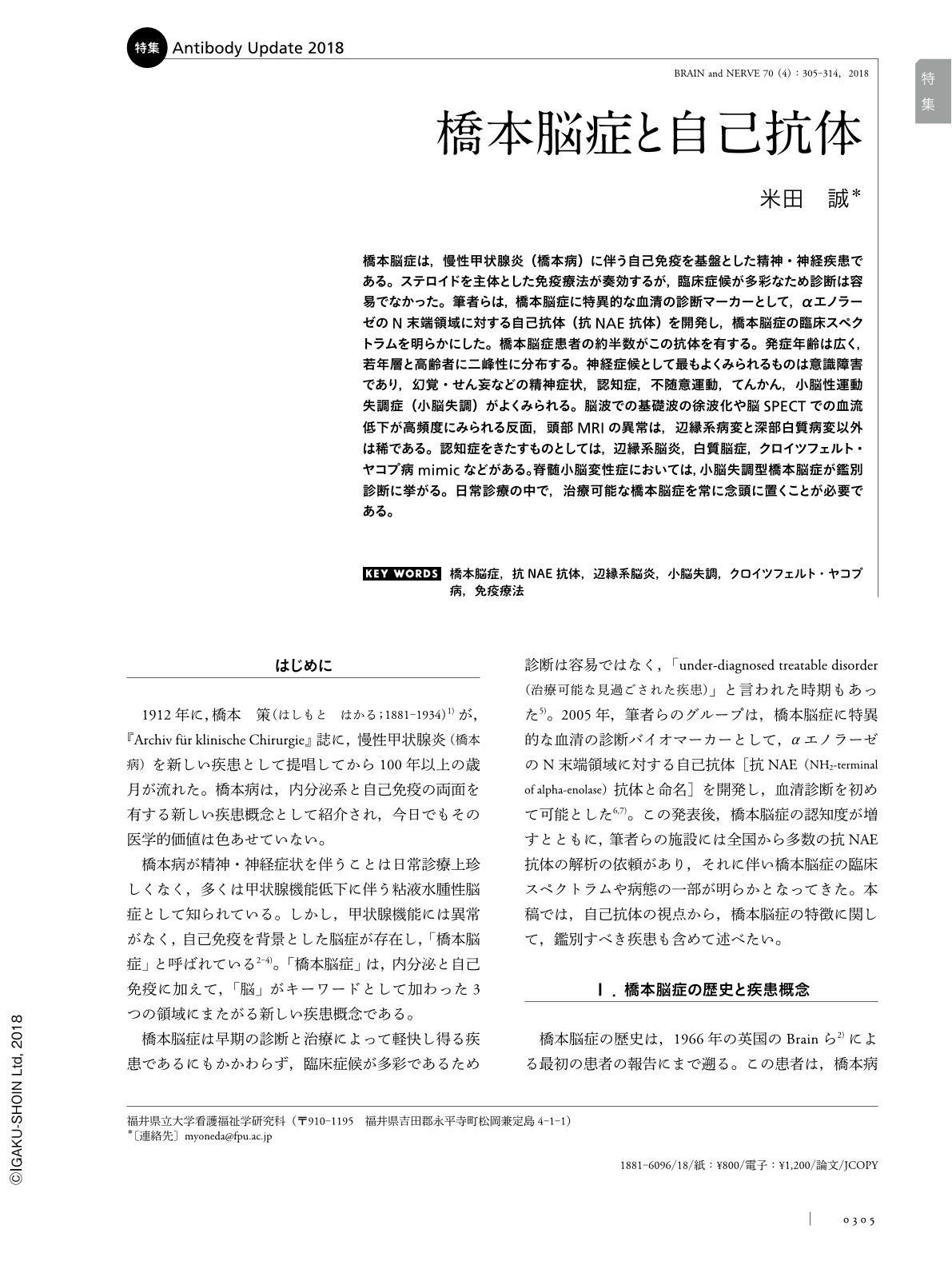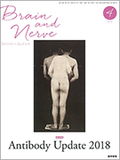Japanese
English
- 有料閲覧
- Abstract 文献概要
- 1ページ目 Look Inside
- 参考文献 Reference
橋本脳症は,慢性甲状腺炎(橋本病)に伴う自己免疫を基盤とした精神・神経疾患である。ステロイドを主体とした免疫療法が奏効するが,臨床症候が多彩なため診断は容易でなかった。筆者らは,橋本脳症に特異的な血清の診断マーカーとして,αエノラーゼのN末端領域に対する自己抗体(抗NAE抗体)を開発し,橋本脳症の臨床スペクトラムを明らかにした。橋本脳症患者の約半数がこの抗体を有する。発症年齢は広く,若年層と高齢者に二峰性に分布する。神経症候として最もよくみられるものは意識障害であり,幻覚・せん妄などの精神症状,認知症,不随意運動,てんかん,小脳性運動失調症(小脳失調)がよくみられる。脳波での基礎波の徐波化や脳SPECTでの血流低下が高頻度にみられる反面,頭部MRIの異常は,辺縁系病変と深部白質病変以外は稀である。認知症をきたすものとしては,辺縁系脳炎,白質脳症,クロイツフェルト・ヤコプ病mimicなどがある。脊髄小脳変性症においては,小脳失調型橋本脳症が鑑別診断に挙がる。日常診療の中で,治療可能な橋本脳症を常に念頭に置くことが必要である。
Abstract
Encephalopathy occasionally occurs in association with thyroid disorders, most of which are treatable. These encephalopathies include a neuropsychiatric disorder associated with hypothyroidism named myxedema encephalopathy. Moreover, Hashimoto's encephalopathy (HE) has been recognized as a new clinical disease based on an autoimmune mechanism associated with Hashimoto's thyroiditis, and can be successfully treated using steroids. Recently, we discovered that the serum autoantibodies against the NH2-terminal of α-enolase (NAE) were a highly specific diagnostic biomarker for HE. We analyzed the serum anti-NAE autoantibodies and the clinical features in many cases of HE from institutions across Japan and other countries. About half the patients with HE had anti-NAE antibodies. Patient age was widely distributed with two peaks (around 20-30 years old and 60-80 years old). Most patients with HE were in euthyroid states and all patients had anti-thyroid antibodies. The common neuropsychiatric features include disturbance of consciousness, psychosis, cognitive dysfunction, involuntary movements, seizures, and ataxia. Electroencephalograph (EEG) abnormalities and decreased cerebral blood flow on brain single positron emission computed tomography are common findings, whereas abnormalities on brain magnetic resonance imaging are rare. Patients with HE present with various clinical phenotypes such as an acute encephalopathy form and chronic psychiatric form. Other clinical forms include limbic encephalitis, progressive cerebellar ataxia, and Creutzfeldt-Jakob disease (CJD)-mimic forms. The cerebellar ataxia form of HE clinically mimics spinocerebellar degeneration (SCD) and is characterized by the absence of nystagmus, absent or mild cerebellar atrophy, and lazy background activity on EEG. Taken together, clinicians should pay attention to the possibility of encephalopathy associated with thyroid disorders.

Copyright © 2018, Igaku-Shoin Ltd. All rights reserved.


